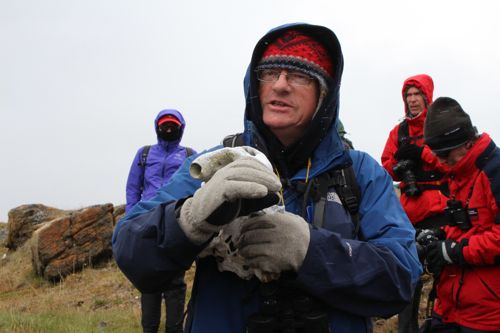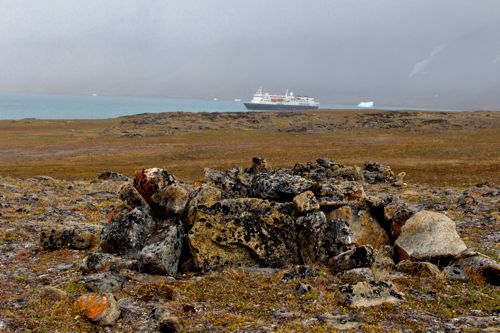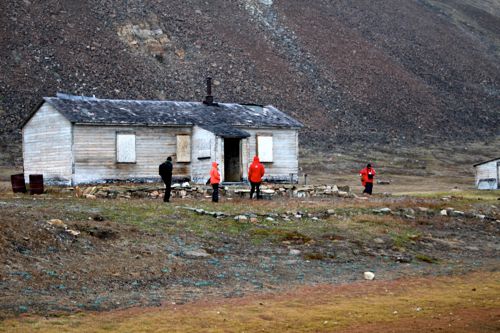Dundas Harbour - August 17th, 2013
Today we visited Dundas Harbour on Devon Island, Canada’s 6th largest island. Despite the late summer date, we experienced weather far harsher than the worst winter day in Tucson, Arizona. It started out with snow and a temperature of 32°F, and progressively got colder, windier, foggier, and the snow turned into a frozen rain that pelted us. It was perfect conditions to gain an understanding of the conditions faced by the people whose remnants we were viewing. After all, we were there on a “nice” summer day, not during the winter.

Thule Site
The ancestors of the today’s Inuit people are the Thule people that lived in the Arctic around 1000 A.D. Today we saw the remains of the tent rings where a Thule house made of sod and stone would have been built. We also saw an ancient midden, or garbage site, that contained a great deal of animal bones. Lastly we had our first introduction to a Thule gravesite. (Stay tuned for more on Thule gravesites on Day 12 journal in Qilakitsoq, Greenland).


Royal Canadian Mounted Police (RCMP) Outpost
As we moved to another side of the harbor, we encountered the remains of the Mountie (RCMP) outpost. The Canadian government established this outpost in August 1924 to create a government presence to curb foreign whaling and other activity in the area. The Mounties (RCMP officers, or constables) were to guard the eastern entrance into the Northwest Passage.

In 1924, there were 3 constables that opened the post. At that time they did little travelling, because of the rugged conditions. For first three years the men didn’t even have radio contact. They had to wait for the annual visit from government ship to receive news. It is hard to imagine such isolation today. During most of our voyage, the guests had access to a satellite-based Internet connection. This became sporadic during our time in the Northwest Passage, however our ship’s officers were still in contact with the outside world the entire time.

The isolation did not bode well for the first group of three officers. Constable Maisonneuve, who began his assignment in August of 1924, was set to transfer out in the summer of 1926. He committed suicide prior to his transfer, on June 16th, 1926. Another constable, W.R. Stephens, accidently shot himself while walrus hunting in the summer of 1927. A small graveyard is maintained by the RCMP on the island, with the remains of the two men, and a young Inuit girl who was the daughter of one of the hunters helping the constables.
We did not get to see the graveyard, since the weather took a turn for the worse. The low visibility created by the fog makes for dangerous conditions when hiking in polar bear country. Here are various images that remain from the site. There was an odd assortment of items left behind, including a jar of peanut butter.

Inuit hunters helped the constables patrol the island by dog team during the years 1929-32, covering thousands of miles. The RCMP left the area in 1933, and leased the buildings to the Hudson Bay Company. They gave it up after a few years, because of harsh conditions and the collapse of fur prices. The government relocated 53 Inuit families there from Baffin Island in 1934. The resupply ship that was supposed to come in the summer didn’t make it. It was so windy and cold the families left in 1936. In September 1945 the RCMP, to maintain a patrol presence in the area, reopened the post. It was permanently closed in August 1951 due to the difficult conditions.

The weather we encountered on our hike today truly deepened our understanding of the history of this area.


Comments